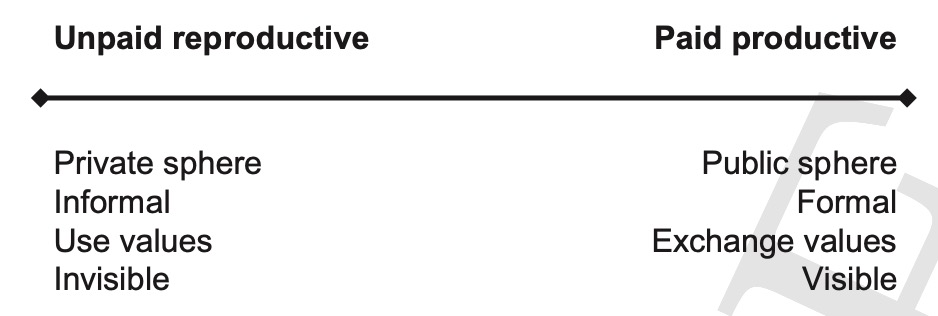20.11.2023 Labor Market Inequalities#
FPE and Labour Market:
gendered institution
unequal power relations
unpaid work = reproductive work
Work as a continuum#
Standard Economics:
Labour market = demand and supply => equilibrium
unemployment = choice
natural rate of unemployment
Womens Position
Preferences
no theory of the household
Labour/ leisure model (opportunity costs)
Housework in Classical
Mincer / Becker: 3 way split (home / leisure / home production)
joint utility function
occupations chosen by lowest opportunity cost
FPE:
houesork = necessary for capitalist production
work = continuum
Right = wage work, formalized & protected
left = work for consumption (e.g. cooking), not „legitimate“ labour
Most = somewhere in the middle => fragmentation

Gender Wage Gap#
only one way of measuring disparities! (e.g. quality of work)
OECD countries = 15% gap
non-OECD countries = more
Classical Explanation = Human Capital Theory
higher skills, qualifications => higher wage
women = lower human capital => lower wage
lower educations
human capital more focused on non-market outcome
Reason for decisions
different preferences
women anticipate less time in wage labor = less investment
lower risk
Anticipation of Discrimination => less investment
discrimination in access
Why dumb:
cost of education
accumulation of privilege by men
reinforcemnt in household
Oversimplified
Segmentation in Labour Market#
horizontal occupational segregation: women in lower-paid & different jobs
vertical occupational segregation: women in lower-paid grades of companies than man
Women in Classical Theory:
considered less reliable
less valuablke to economy
different type of jobs (because investment in other skills)
=> horizontal occupational segregation (women do different jobs)
also:
nurturing nature
lower physical abilities
less likely to join union
vertical segregation
women too emotional
conflict with responsibilites at home
=> glass ceiling
FPE:
lack of mobility
inequality in choices
Discriminatory policies
labour-market segmentation theory
primary market: good jobs, stable employment, low turnover (think auto worker)
secondary market: insecure, high turnover, no security (think cashier)
Time use#
different use of time of genders, women:
More time in repr. labor
not classified as economic activity
Key factor for inequality
Time = commodified factor, gendered usage
time agency: confidence and ability to make and act upon strategic choices about how to allocate one’s time
Women = less time agency
paid + unpaid work
less time for investment in human capital (Abendschule)
=> vertical segregation
home based work = more flexibility
choice of part time work
=> horizontal segregation
Interventions for equality#
Types of Equality:
eq. of outcome
eq. of opportunities
Policies
public infrastructure => more time autonomy
indirect: investment in education, water-dwelling etc.
care-leave
but could be counterproductive
because of gendered usage
Labor Market Change#
Globalization => Outsorcing in low-wage countries
pro: growth in manufacturing, employment creation
Contra: unequal power relations => poor conditions
often subcontracted
non-standard types of employment
Women = concentrated at lower end of hierarchies
fragmented labor markets: labour markets defined by an accumulation of insecurities, non-standard employment + low wages
also
Gig Work
Pro: flexibility
Contra: extreme pressure
reduced access for women (less phones)
Covid 19#
Gendered impacts
higher susceptiblity of encountering the virus (hospital etc.)
increase in unpaid care work (closing of daycare etc.)
emplyoment suffered in sectors (restaurants / hospitality)
Questions#
Using critiques developed by feminist political economy, describe the weaknesses in theories that characterize the labour market as a divided institution.
Given the benefits of employment for women, are low-paying precarious jobs better than no jobs?
Is economic growth based on exploitation justified if there is a promise of prosperity in the future?
Using a case study of your choice (by government or the private sector), describe how an intervention aimed at reducing gender inequality in the labour market may be undermined by women’s disproportionate responsibility for unpaid or unwaged work.